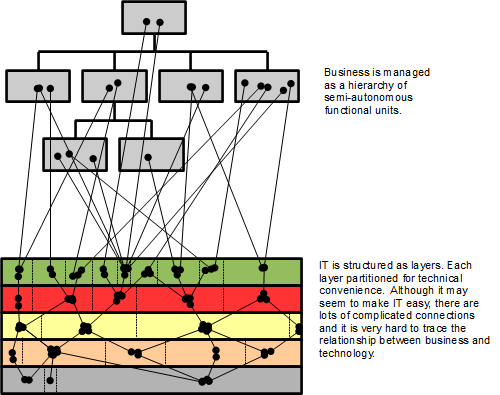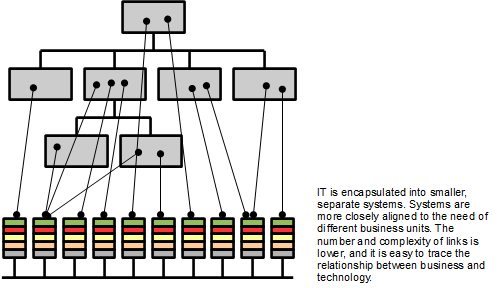
| Previous | Next | Printer friendly |
Back to basics: The importance of structure
To overcome the really big problems in IT we need to change how IT is structured.
The first really big problem is that IT projects are difficult, expensive and full of risk. The second is the legacy of old systems which are difficult to work with, run on out-of-date technology, and don't do what business needs.
Although these problems seem very different they can be traced back to a common cause: we structure IT for the convenience of technologists, not for the convenience of business and IT management.
In the past, IT has been expensive and technically difficult. We have found ways to make the best use of expensive resources and to make IT easier to implement. We have arranged IT into shared technical layers (network, operating system, database, application software, user interface) to exploit economies of scale and expertise. We have encouraged sharing of IT capabilities to reduce cost, and use common databases to allow different applications to share data.
We have successfully created structures which are optimised technologically. Buy they are misaligned to business and to long-term IT management needs. Most organisations are hierarchies of semi-autonomous departments defined by function. But IT is structured totally differently, as shared layers of technical capability.

If you follow the trail of cause and effect, nearly every major problem in IT has roots in the IT structures that we typically use. It is very difficult to make the connection between a business change and the required IT changes. This leads to IT-led business solutions, rather than business-led IT solutions. Everything is interconnected, and it is hard to identify and justify what needs to be done to keep IT current and manageable. Systems slip into unmanageable legacy. The sharing and connections between systems are so complicated that every change has a huge knock-on effect. The complexity of IT and the lack of effective business control leads to large, expensive IT projects that are prone to failure.
Read more on IT problem cause and effect.
IT is now much cheaper and we have developed much better ways of managing it. We have the opportunity to move to more aligned IT structures. The ideal is a set of separate, encapsulated capabilities which are meaningful in business terms and which provide appropriate units for IT management.

Although it is technically easy to move to a more aligned structure it is emotionally and politically hard. We have spent decades defending the structures that we have.
The first argument against aligned structures is that it makes it much harder to connect systems. However, modern methods of integration, particularly messaging middleware and web services, allow separate systems to work together seamlessly.
The second argument is that aligning IT to business structures preserves the inefficiencies of current business operations. However, a set of understandable, separate, but closely integrated systems is the best basis for enabling business to optimise processes.
To achieve minimal IT, we need to bend technology around structures that make sense to our organisations and which help us with the really difficult problems of long-term IT management. We need to move on from the structures of yesterday.
Next: Back to basics: Proactive IT managementSubscription
Latest newsletter:
Magical metadata
We use the term "metadata-driven" to describe IT solutions in which functionality is defined in data. Taking this to the extreme can provide unparalleled levels of speed, simplicity and versatility.
Read full newsletter
System governance
System governance helps you implement high-quality systems, manage existing systems proactively, and improve failing systems.
Copyright © 2005-2015 Minimal IT Ltd. All rights reserved.
Minimal IT: research, training, consultancy and software to reduce IT costs.
